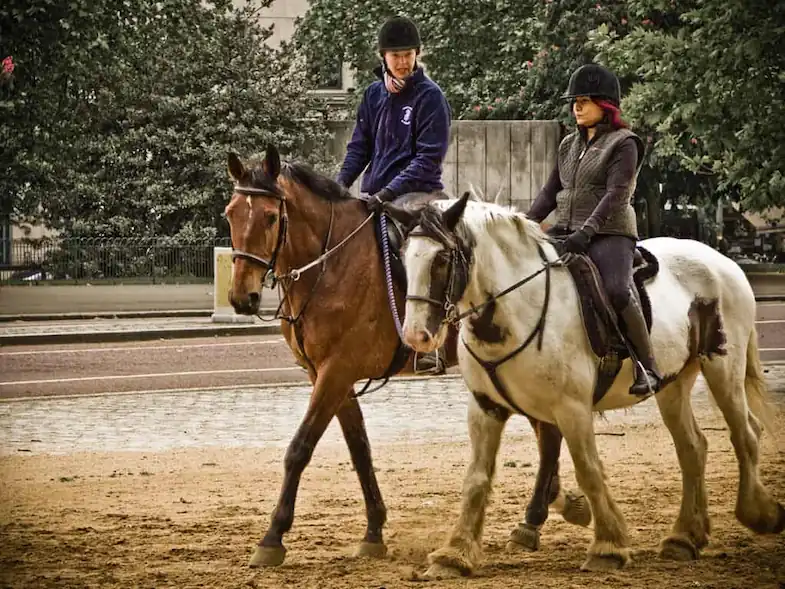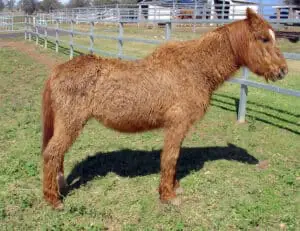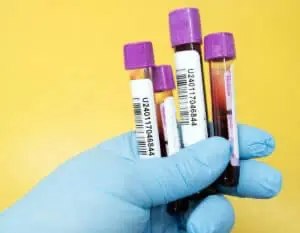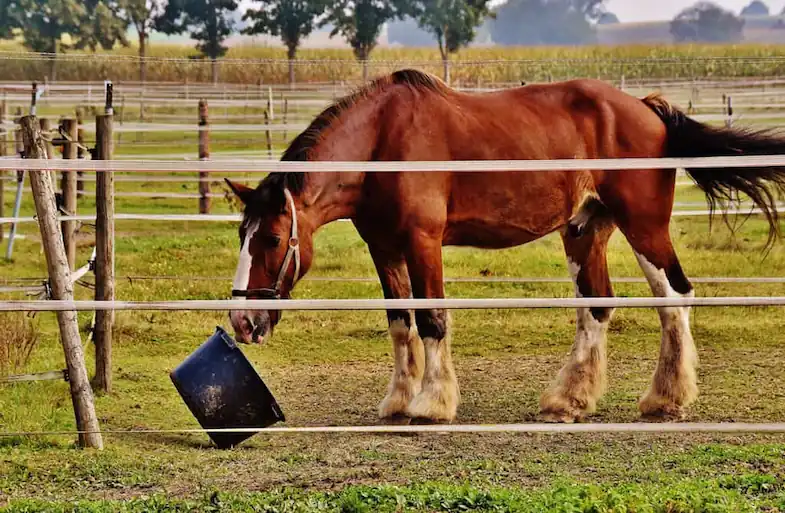Hopefully, you’ll never have to deal with Equine Cushing’s Disease but with 20% to 33% of horses over the age of 15 suffering from it its important to not only know what to look out for but also how to manage the condition. A distinctive long curly coat is the most noticeable and well-known symptom but because the disease affects the regulation of the hormones there is also a range of other, seemingly unrelated, symptoms.
What is Equine Cushing’s Disease?
Also known as Pituitary Pars Intermedia Dysfunction (or PPID), Equine Cushing’s Disease is the most common hormone or endocrine (glands that manufacture hormones and other products directly into the bloodstream) disorder in horses. It affects the pituitary gland which is situated at the base of the brain and produces hormones. It can be caused by either an enlargement of the pituitary gland or a tumor that affects the gland. Sadly there’s no cure for it but with careful management, a horse can live a relatively normal life with the condition.
What causes Equine Cushing’s Disease in horses?
There’s no definitive ‘one’ cause for Equine Cushing’s Disease as it can affect all breeds regardless of age, weight, and lifestyle. While it is more common in older horses and those that are obese it does affect younger horses and those that are of a normal weight.
One cause is thought to be stress, this is because horses living in a high-stress environment will have an increased level of cortisol as well as higher adrenal levels, and it’s known that these can trigger a hormone imbalance which can be a factor in the development of Equine Cushing’s Disease. This can also be the case for horses that spend many years on high sugar and high starch diets.
What are the symptoms of Equine Cushing’s Disease?
Equine Cushing’s Disease is slow developing so it can take a long time for any clinical signs to show but because it affects the horse’s ability to regulate the amount of hormone that’s produced it means that the whole body is swamped by hormones, this is why the symptoms are wide and varied. The most common symptoms though are:
- Long, curly, or wavy hair (also known as hypertrichosis).
- Delay in the winter coat being shed.
- Muscle wastage and a rounded abdomen (often called a potbelly).
- Fat deposits over the body (especially along the crest of the neck and over the tail).
- A loss of energy, typically displayed as a reduction of physical performance as well as lethargy.
- Excessive drinking (polydipsia) and urinating (polyuria).
- Abnormal and excessive sweating.
- Prone to laminitis.
- Reoccurring infections.
- Reproductive issues including infertility.
- Neurological problems such as seizures and even blindness.
Of course, all horses are different and they won’t all suffer from the same symptoms but horses with Equine Cushing’s Disease are also more likely to affected be internal parasites and will often take much longer to heal from wounds and infections.
How is Equine Cushing’s Disease diagnosed?
In the past the disease was diagnosed by clinical symptoms alone and while these are still used in part to visually diagnose the disease a blood test can be carried out to confirm it. The blood test is designed to measure the adrenocorticotropic hormone (ACTH) in the blood plasma which is often higher in horses with Equine Cushing’s Disease.
During the fall months, all horses will produce higher levels of ACTH and it was thought that that made tests undertaken during this time unreliable but recent studies have shown that horses suffering from Equine Cushing’s Disease will continue to produce even higher amount than other horses.
One drawback to the test though is that in the very early stages, due to the slow onset of the disease false negatives are common.
Can you treat Equine Cushing’s Disease?
Once your veterinarian has confirmed the diagnosis he will also advise you on how to best manage the condition in your horse but there are three main categories that any treatment (or management) will fall into, diet, medical, and infection prevention.
It’s also worth noting that, due to the long coat that isn’t shed so regularly, horses with Equine Cushing’s Disease often have trouble regulating their temperature. This is why many owners will clip their horses all year round.
Diet
The best way to manage Equine Cushing’s Disease is with diet, this will help to keep their weight down (or up if your horse is underweight) but will also reduce the amount of sugar that they consume which will help to prevent laminitis to some extent.
When feeding horses with Equine Cushing’s Disease it’s important to keep the following in mind:
- Reduce grazing – Cutting down on the amount of grass your horse eats will avoid any sudden increases in carbohydrates that can cause a bout of laminitis. You shouldn’t restrict the amount of hay your horse eats though.
- Feed a balanced diet – While you will need to control the amount of sugars and starches (ie carbohydrates) your horse has, you should still continue to feed him a balanced diet. Make sure he’s getting the correct number of vitamins and minerals as well as enough protein and calories.
- Keep feed sizes small – You should be feeding less than 2kg a meal to your horse (or around 1.5kg for ponies).
- Feed little and often – A horse’s digestive system is designed to continuously digest food which is why it’s important to feed little and often. Also feeding a horse this way will avoid spikes in insulin and blood glucose.
- Use feeds that are low in sugars and starches – Too many sugars and starches will increase your horse’s insulin levels so you want to keep these to a minimum.
- Avoid too many grains – Things such as oats, corn, and barley are extremely high in starch so shouldn’t be fed in large amounts to horses with Equine Cushing’s Disease.
- Soak hay – Soaking hay for 12 to 16 hours (or 6 hours in warm weather) will cut the number of water-soluble carbohydrates in half.
- Make changes slowly – Just because your horse has been diagnosed with Equine Cushing’s Disease it doesn’t mean you should instantly change his diet. Any change that you make should be done over a period of a week or two to avoid unnecessary stress.
- Body condition – It can be difficult to keep the weight of horses with Equine Cushing’s Disease down but you want to aim for a body condition score of around 5.
Medical
There are a number of treatments, such as dopamine agonists, serotonin antagonists, and cortisol antagonists, can be used to create the disease but while these are extremely effective (with a 65% to 85% success rate) there are a number of side effects. Of course, not all horses will suffer from any of these side effects but they can range from diarrhea and colic to anorexia and depression.
Infection prevention
The immune system of horses with Equine Cushing’s Disease is compromised which means that the horse is prone to bouts of infection and that its harder for them to fight off any infection and for wounds and injuries to heal. With this in mind, it’s absolutely crucial that your horse is vaccinated and dewormed regularly. He should also have his teeth and hooves checked at regular intervals. Some people also use supplements containing vitamins and minerals that are designed to boost weakened immune systems.
Can you treat Equine Cushing’s Disease naturally?
While you can’t cure the disease naturally you can use a variety of natural ingredients to reduce the effect it has on your horse as well as to address some of the symptoms.
- Antioxidants – Such as those found in berries will help to fight oxidative stress as well as help to boost the immune system.
- Adaptogens – Like antioxidants, plant adaptogens (such as those found in many herbs) will improve the body’s ability to deal with stress.
- Chaste Tree Berries – Also known as vitex, the extract from these berries will help to regulate the produce to hormones.
- Amino Acids – Every living creature needs amino acids to survive but acids such as lysine, methionine, and threonine will help to support your horse’s lean muscle mass.
- Omega 3 – Amongst other things (such as improving eye health), omega 3 will also help your horse’s body to reduce inflammation as well as regulate his insulin levels.
What happens if Equine Cushing’s Disease is left untreated?
Horses that suffer from Equine Cushing’s Disease are prone to laminitis as well as infections and problems with internal parasites such as worms which is why it’s important to manage the condition. Not doing so will result in a great deal of suffering as the horse is afflicted by increased bouts of chronic disease, severe laminitis, and internal issues. This will result in a rapid decline in health and comfort which will ultimately impact on your horse’s quality of life.
How long do horses with Equine Cushing’s Disease live for?
Equine Cushing’s Disease isn’t curable but that doesn’t automatically mean that its fatal and in fact, with good management a horse can live a normal life for five to seven (or more) years after diagnosis. The key to this though is good management and care, so while you may need to change your horse’s diet and control his grazing there is no reason why your horse should suffer in any way.
Can you still ride a horse Equine Cushing’s Disease?
In most cases, there’s no reason at all why you can’t ride your horse if he has Equine Cushing’s Disease and in fact, many horses will benefit from the exercise. The things you need to take into account when you are riding though are:
Overheating
Many horses with Equine Cushing’s Disease will have a long, thick coat that will make it harder for them to keep themselves cool. This doesn’t mean that you shouldn’t ride your horse, just that you should keep in mind that he won’t be able to keep cool so easily. Clipping your horse will help with this though.
Eye sight
Blindness is a symptom of Equine Cushing’s Disease, albeit at the advanced stage fo the disease, so this needs to be taken into account when riding. If your horse has any loss of vision then you should speak to your veterinarian before riding him.

How is Equine Cushing’s Disease different from Equine Metabolic Syndrome?
While both Equine Cushing’s Disease and Equine Metabolic Syndrome (EMS) are endocrine (or hormone) disorders and can both increase the horse’s susceptibility to laminitis they are in fact very different conditions. Yes, they do share a lot of symptoms but the main difference is that EMS affects a horse’s ability to produce insulin (which is why it sometimes referred to as an insulin-resistant condition) whereas Equine Cushing’s Disease only affects the pituitary gland.
Another difference between the two is the age with which horses are most likely to suffer, EMS can affect horses from the age of 5 but is more common in horses under the age of 15 while Equine Cushing’s Disease will affect horses that are typically over the age of 15, with the average age being 19.
Recent studies have indicated that horses with EMS are more likely to suffer from Equine Cushing’s Disease later in life, although more research needs to be carried out before this can be known for sure.
Further reading
- Do horses need shoes?
- When should you retire a horse?
- Mud fever explained
- Strangles in horses
- Treating ulcers naturally
- Dealing with arthritis
- Caring for an old horse
- Do horses need supplements?
- The facts about equine flu
- Horse euthanasia explained
I hope you found this article helpful. If you did I’d be grateful if you could share it please as it would really help me.
Recommended products
Over the years I have tried hundreds of different horsey products, from various blankets and halters to different treats. Some I’ve loved, others I’ve hated but I thought I’d share with you my top all-time favorite products, the ones I never leave the yard without. I’ve included links to the products (which are in no particular order) that I really think are great.
- Horse Knots by Reference Ready – If you’re like me and enjoy pocket reference guides then you’ll love this knot tying guide. These handy cards can easily fit in your pocket or attach to the saddle for quick reference. They’re waterproof, durable and are color coded to make them easy to follow.
- Mane ’n Tail Detangler – Even if you never show your horse you’ll need to detangle his tail from time to time (and possibly his mane too) which is always a challenging chore! I’ve found that if I run a little bit of detangler through my horse’s tails every few days it stops them from getting matted up and makes combing them easy, even if they’re coated in mud. I don’t know if I should admit to this or not but it also works wonders on my hair.
- TAKEKIT Pro clippers – Over the years I’ve tried a lot of different clippers and while some were obviously better than others I found these to be by far the best. They are heavier than a lot of other clippers but for me, that’s a good thing, it makes them feel more sturdy and hardwearing. On top of that they have a range of speeds so are just as good for clipping your horse’s back as they are his face. I also like the fact that they come in a handy carry case but that’s not for everybody. The company that makes them is super good and incredibly helpful too, a real bonus these days. The only thing I wasn’t keen on was the fact that it doesn’t come with any oil, but that’s not a major problem as it’s not difficult to buy lubricant.
- Shire’s ball feeder – There are so many boredom buster toys out there but I like to use these every day, regardless of whether or not my horses are bored. I find that it helps to encourage my horses to problem solve by rewarding them with treats (or pieces of fruit) but it also mimics their natural grazing behavior which helps to keep them calm and de-stressed.
- Horse safe mirror – This is a strange one that many people are surprised about but I like to put horse safe mirrors in the trailers as well as in the quarantine stalls. It helps to prevent the feeling of isolation by giving the impression of other horses being around. Being herd animals horses can get extremely stressed when they feel that they’re on their own but with these stick-on mirrors, they believe that at least one other horse is with them.
- Rectal thermometer – I know this isn’t glamourous at all but it’s vital for your horse’s well-being to be able to check their temperature and a rectal thermometer is the easiest way of doing this which is why I’ve added it to the list.
Shopping lists
I’ve also put together a few shopping lists of essential items that I’ve found helpful over the years. I’ve broken the lists down into different categories rather than put everything in one massive list 😉




